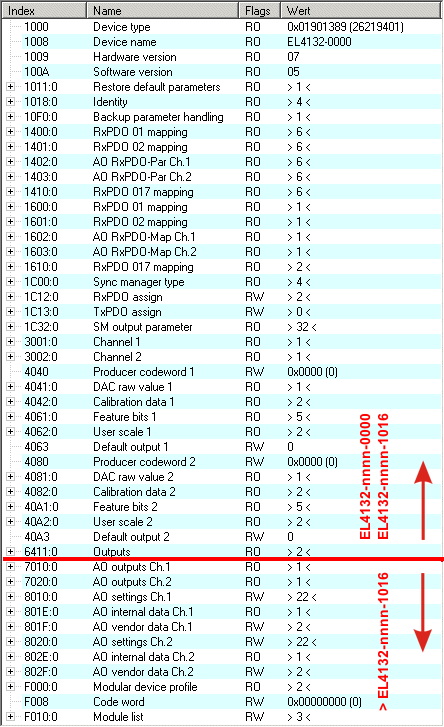Feature sets of the EL41x2
The further development of the EL41x2 provides several feature sets that can be parameterized in the TwinCAT System Manager, depending on the hardware. Later versions are downward compatible so that older versions can be replaced. The description of the "normal functionality" for all ESIs up to "EL41x2-nnnn-0016" can be found in the appendix
FW/HW functionality | ESI | Functional description |
|---|---|---|
before FW/HW: | from EL41x2-nnnn-0000 | Basic functions (normal functionality): - Analog output signal, 16-bit, short-circuit proof |
from FW/HW: | from EL41x2-nnnn-1016 | Basic functions and additional functions (extended range of functions): |
Table 1 Functionality depending on hardware version
The functionality of an EL41x2 that is newly integrated in the system depends on the hardware/firmware version.
Specific settings are described in the following two chapters.
 | Process data monitoring
|
Compatibility
The scope of the EL41x2 CoE list differs, depending on the firmware version. Later hardware versions contain all earlier CoE entries (see Fig.).
 Fig.151: CoE list for different hardware/firmware versions
Fig.151: CoE list for different hardware/firmware versionsThe following section describes the behavior of objects with normal and advanced functionality.
Boolean objects, index 0x4061 or 0x40A1 (feature bits) and index 0x8010 or 0x8020 (AO settings)
Some boolean objects, which are used for parameterization, are available with redundancy in the advanced functionality (feature bits 0x4061 or 0x40A1 and “AO settings” 0x8010 or 0x8020) and are linked with an OR function.
Example boolean objects:
In the advanced functionality the user scaling for channel 1 is activated (index 0x8010:01 = TRUE). This status is not automatically transferred to the associated compatibility object 0x4061:03. If the status in object 0x4061:03 = FALSE, “Enable User Scale” = TRUE applies for the functionality after the OR function.
The objects for normal and advanced functionality are compared in Table 2:
EL41x2-nnnn-0000 | > EL41x2-nnnn-1016 |
|---|---|
0x40x1:01 (Disable Watchdog timer to set output) | n/a |
0x40x1:02 (Enable user default output) | n/a |
0x40x1:03 (Enable user scale) | 0x80x1:01 (Enable user scale) |
0x40x1:04 (Enable absolute value with MSB as sign) | 0x80x1:02 (Presentation)*** |
0x40x1:05 (Enable absolute value) | 0x80x1:02 (Presentation)*** |
Table 2: Comparison of boolean objects with normal and extended functionality
Representation objects (presentation)
With normal functionality, objects 0x4061:04 and 0x4061:05 are used for switching between the methods of representation of the output values. The bit that is activated first is treated with priority. Setting of another notation bit has no effect.
Example representation objects:
Both notation bits in objects 0x4061:04 and 0x4061:05 are not set. The bit in object 0x4061:05 (“Enable absolute value”) is set to TRUE, and the output value is displayed as an absolute value. If object 0x4061:04 is switched to TRUE (“Enable absolute value with MSB as sign”), the method of representation remains in the previously selected mode.
 | ***Extended functionality: Representation object 0x8010:02 or 0x8020:02 (enum object) With advanced functionality, it is recommended to use only object 0x8010:02 or 0x8020:02 for switching the method of representation. |
Calibration objects (index 0x4062 or 0x40A2 (user scale) and index 0x8010 or 0x8020 (AO settings)
Calibration objects are mirrored to the compatibility objects available with normal functionality.
Example calibration objects:
Object 0x8010:11 (offset): If value of “0x3FFF (16383dec)” is entered here, for example, it is transferred to compatibility object 0x4062:01.
The objects for normal and extended functionality are compared in Table 3:
EL41x2-nnnn-0000 | > EL41x2-nnnn-1016 |
|---|---|
0x40x2:01 (Offset) | 0x80x0:11 (Offset) |
0x40x2:02 (Gain) | 0x80x0:12 (Offset) |
n/a | 0x80x0:15 (User calibration offset) |
n/a | 0x80x0:15 (User calibration gain) |
Table 3: Comparison of calibration objects with normal and extended functionality